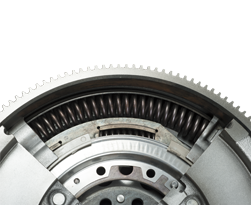Car concentric slave cylinders

Along with technologies and new car manufacturers’ requirements, it has become difficult to fit a cable in a straight line between the pedal and the lever. That’s why more and more cars are now using hydraulic systems. These are much more flexible and reliable compared to manual systems. First, they enable an optimal and constant pedal effort.
Second, the used material is much lighter (up to 70% reduction of weight compared to the standard clutch system command) as well as much more compact. This is the main reason why this technology is easier to implement on OE projects. In response to this market trend, Valeo has developed a wide range of hydraulic parts: clutch master cylinder (CMC), clutch release cylinder (CRC) and clutch slave cylinder (CSC). Both the clutch master cylinder and the clutch release cylinder are used in “semi-hydraulic” system, whereas a “full hydraulic” system uses CMC and clutch slave cylinder.
In 2017, 131 million of vehicles are expected to be equipped with a CSC. As in the “semi hydraulic” system, the full-hydraulic system is based on the same principle as hydraulic brakes and consists of a transmitter (the CMC), a hose and a receiver. In “full-hydraulic”, the receiver is a concentric salve cylinder (CSC).
The CSC is a hydraulic cylinder with an integrated release bearing which eliminates the clutch lever and the conventional release bearing. It is connected to the master cylinder via the hose. The CSC is in direct contact with the clutch cover diaphragm, increasing the efficiency of the hydraulic system.
Advantage of the CSC is to eliminate the fork and the release bearing. There are no more deformations of the fork under load and the release system efficiency is increased. Therefore the pedal load is reduced. The CSC is concentric to the gear box input shaft. This also reduces the number of components which facilitates the assembly on the vehicle. Until 95’s, the clutch hydraulic release system technology was similar to the brake hydraulic technology and consisted of a master cylinder in aluminum and a cast iron release cylinder connected with a pipe made of steel and rubber.
The weight of the sub assembly is about 1,000 grams. The full function with bearing, fork and guiding tube, weighs about 1,700 grams. From early 95’s the widespread use of plastic materials and of CSC, both weight and costs of the parts are considerably reduced. From now on, the total weight of the sub assembly (CMC, pipe, CSC) is up to around 400 grams.
Due to the disappearance of the release bearing, the fork and the guiding tube, the complete hydraulic function reduced its weight by 75%. Valeo Info As the CSC is located inside the transmission housing, the replacement of the part is much longer (same time as a clutch replacement) than in the semi-hydraulic systems. Therefore, you should systematically change the CSC when replacing a clutch.







